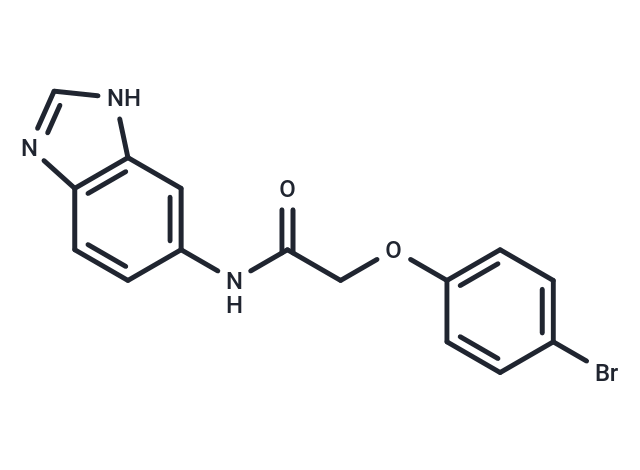Shopping Cart
- Remove All
 Your shopping cart is currently empty
Your shopping cart is currently empty

P2Y14R antagonist 1 (compound I-17) is a potent and selective antagonist of the P2Y14 receptor, exhibiting an IC50 of 0.6 nM. This compound demonstrates robust anti-P2Y14R activity, effectiveness both in vitro and in vivo, and favorable pharmacokinetic properties. Additionally, P2Y14R antagonist 1 reduces the release of inflammatory mediators and cell pyroptosis through the NOD-like receptor family pyrin domain containing 3 (NLRP3)/gasdermin D (GSDMD) signaling pathway. It shows promise for research in the field of acute gouty arthritis.

| Pack Size | Price | Availability | Quantity |
|---|---|---|---|
| 10 mg | Inquiry | 10-14 weeks | |
| 50 mg | Inquiry | 10-14 weeks |
| Description | P2Y14R antagonist 1 (compound I-17) is a potent and selective antagonist of the P2Y14 receptor, exhibiting an IC50 of 0.6 nM. This compound demonstrates robust anti-P2Y14R activity, effectiveness both in vitro and in vivo, and favorable pharmacokinetic properties. Additionally, P2Y14R antagonist 1 reduces the release of inflammatory mediators and cell pyroptosis through the NOD-like receptor family pyrin domain containing 3 (NLRP3)/gasdermin D (GSDMD) signaling pathway. It shows promise for research in the field of acute gouty arthritis. |
| Targets&IC50 | P2Y2 Receptor:> 100 nM, P2Y1 Receptor:> 100 nM, P2Y14 Receptor:0.6 nM, P2Y6 Receptor:89.7 nM, P2Y12 Receptor:> 100 nM |
| In vitro | P2Y14R antagonist 1 (compound I-17) at concentrations below 256 μM (2-256 μM, 24 hours) did not exhibit significant cytotoxicity in RAW264.7 cells. Additionally, this compound (10-40 μM, 1 hour) antagonizes the effects of uric acid sodium and lipopolysaccharides, demonstrating properties that inhibit gout-related inflammation. Furthermore, P2Y14R antagonist 1 (10-40 μM, 1 hour) acts upstream of NLRP3 inflammasome assembly, inhibiting subsequent caspase-1 activation and macrophage pyroptosis. |
| In vivo | Compound I-17, a P2Y14R antagonist, administered intraperitoneally at doses ranging from 5-20 mg/mL, demonstrated effective anti-inflammatory properties in a murine model of acute gouty arthritis induced by monosodium urate (MSU) crystals. The administration, done over a period of 60 minutes, resulted in a considerable reduction of paw swelling and a significant decrease in the levels of pro-inflammatory cytokines such as IL-1β, IL-6, and IL-18. Additionally, it effectively suppressed the NLRP3 inflammasome activation and markedly reduced inflammatory cell infiltration within the foot tissues of the affected mice. This indicates the potential therapeutic effectiveness of compound I-17 in managing acute gouty arthritis symptoms. |
| Molecular Weight | 346.18 |
| Formula | C15H12BrN3O2 |
| Cas No. | 2728291-29-8 |
| Storage | Powder: -20°C for 3 years | In solvent: -80°C for 1 year | Shipping with blue ice. |

Copyright © 2015-2025 TargetMol Chemicals Inc. All Rights Reserved.